Unit 3 Could you please tell me wherethe restrooms arePeriod 1(Section A 1a-2d)课件(共12张PPT)
文档属性
| 名称 | Unit 3 Could you please tell me wherethe restrooms arePeriod 1(Section A 1a-2d)课件(共12张PPT) | 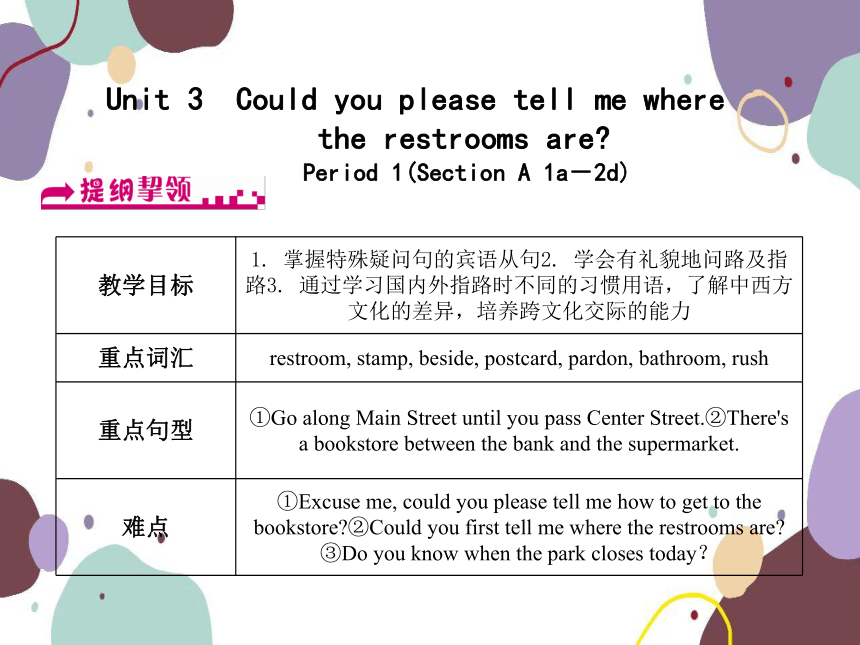 | |
| 格式 | pptx | ||
| 文件大小 | 218.9KB | ||
| 资源类型 | 教案 | ||
| 版本资源 | 人教新目标(Go for it)版 | ||
| 科目 | 英语 | ||
| 更新时间 | 2022-10-21 18:45:58 | ||
图片预览

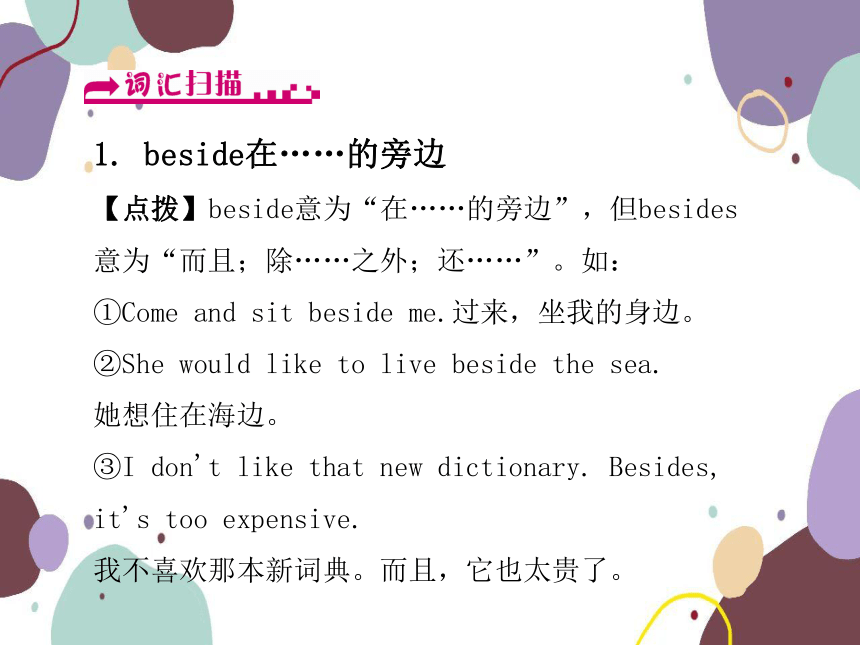

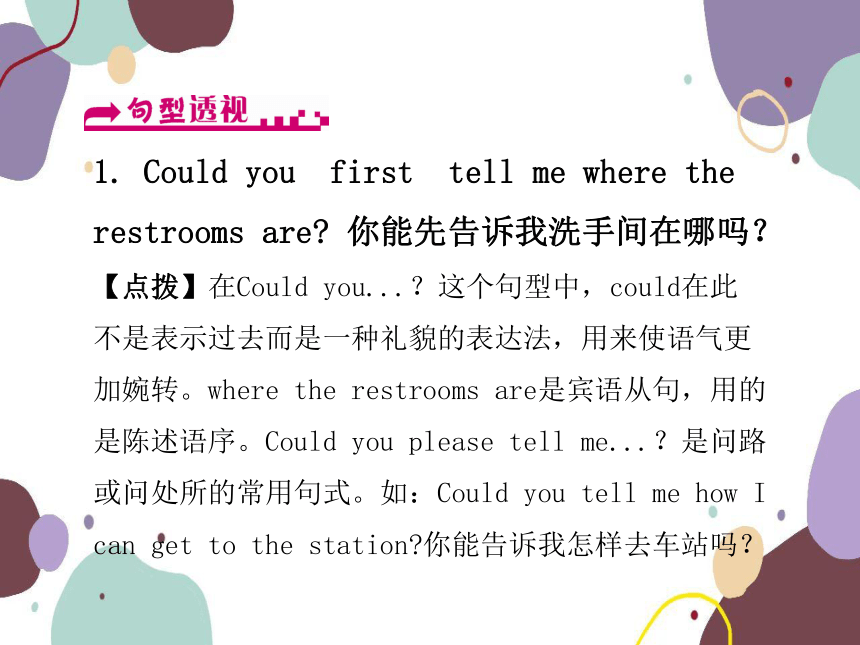
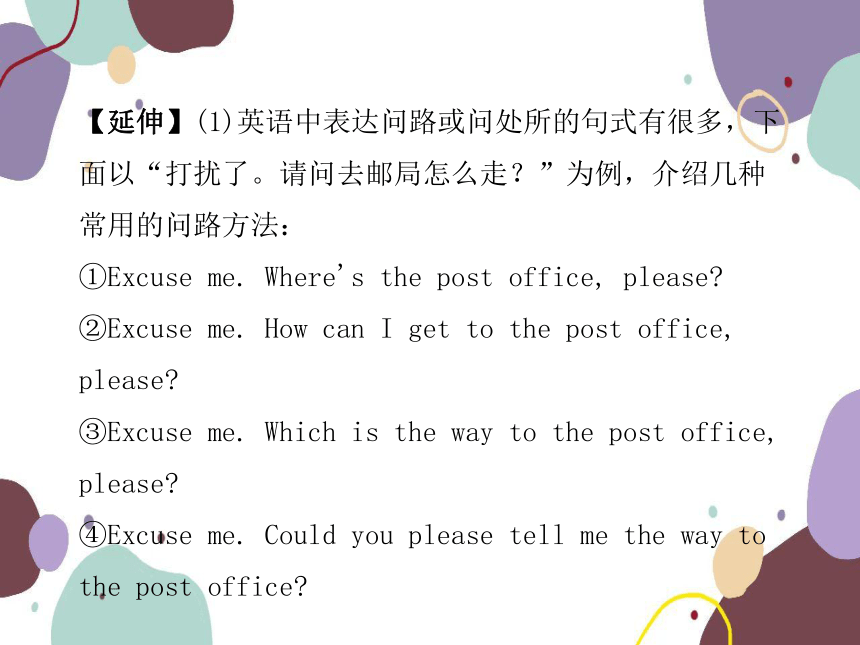
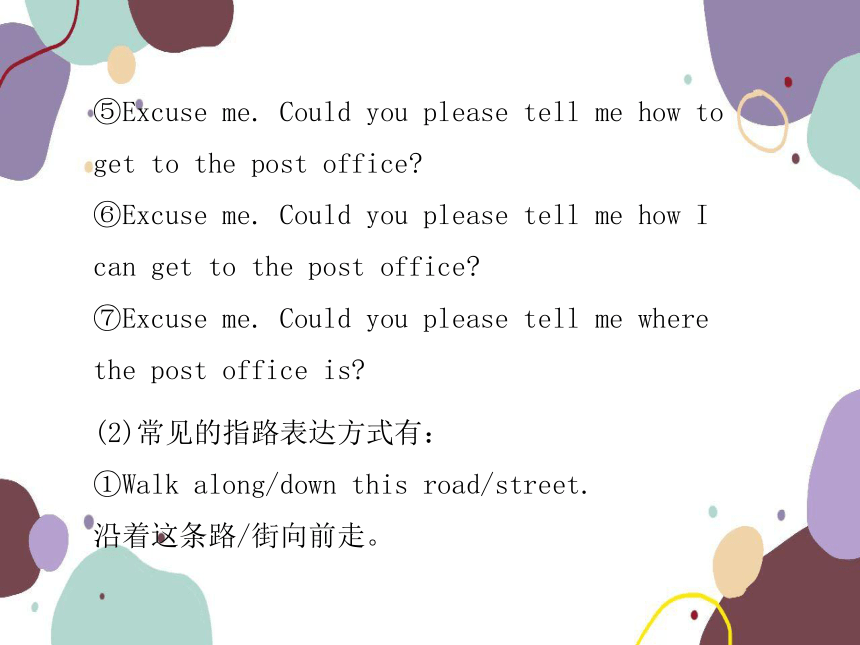
文档简介
(共12张PPT)
Unit 3 Could you please tell me where
the restrooms are
Period 1(Section A 1a-2d)
教学目标 1. 掌握特殊疑问句的宾语从句2. 学会有礼貌地问路及指路3. 通过学习国内外指路时不同的习惯用语,了解中西方文化的差异,培养跨文化交际的能力
重点词汇 restroom, stamp, beside, postcard, pardon, bathroom, rush
重点句型 ①Go along Main Street until you pass Center Street.②There's a bookstore between the bank and the supermarket.
难点 ①Excuse me, could you please tell me how to get to the bookstore ②Could you first tell me where the restrooms are ③Do you know when the park closes today?
1. beside在……的旁边
【点拨】beside意为“在……的旁边”,但besides意为“而且;除……之外;还……”。如:
①Come and sit beside me.过来,坐我的身边。
②She would like to live beside the sea.
她想住在海边。
③I don't like that new dictionary. Besides, it's too expensive.
我不喜欢那本新词典。而且,它也太贵了。
2. pardon什么;请再说一次
【点拨】(1)pardon常用于请求别人重复某事。如:
Pardon What did you say just now
你刚才说了什么?请再说一遍。
(2)Pardon?是简略的说法,其完整形式为:Beg your pardon. 或I beg your pardon.
1. Could you first tell me where the restrooms are 你能先告诉我洗手间在哪吗?
【点拨】在Could you...?这个句型中,could在此不是表示过去而是一种礼貌的表达法,用来使语气更加婉转。where the restrooms are是宾语从句,用的是陈述语序。Could you please tell me...?是问路或问处所的常用句式。如:Could you tell me how I can get to the station 你能告诉我怎样去车站吗?
【延伸】(1)英语中表达问路或问处所的句式有很多,下面以“打扰了。请问去邮局怎么走?”为例,介绍几种常用的问路方法:
①Excuse me. Where's the post office, please
②Excuse me. How can I get to the post office, please
③Excuse me. Which is the way to the post office, please
④Excuse me. Could you please tell me the way to the post office
⑤Excuse me. Could you please tell me how to get to the post office
⑥Excuse me. Could you please tell me how I can get to the post office
⑦Excuse me. Could you please tell me where the post office is
(2)常见的指路表达方式有:
①Walk along/down this road/street.
沿着这条路/街向前走。
②Turn left/right at the+序数词+crossing/turning, and then walk straight.
在第……个十字路口/拐弯处左/右拐,然后直走。
③You can take the No.+数字+bus and get off at...你可以乘……路公共汽车在……站下车。
④It's next to/across from...它在……隔壁/对面。
⑤Walk on and turn left/right, and you'll see it.
继续向前走,然后左/右拐,你就会看见它了。
⑥Go/Walk up the street/road to the traffic lights, and turn left/right.
沿着这条街/路一直走到红绿灯处,然后左/右拐。
2. Go past the bookstore. 从书店旁边经过。
【点拨】go past意为“从……旁经过”,相当于pass by的用法。如:
Go past the bank.=Pass by the bank.
从银行旁边经过。
【辨析】through, past, cross, across与over
(1)through是介词,意为“从……通过;穿过”,主要指从物体内部穿过,含有空间的概念。如:
He got into the room through the back door.
他从后门进入了房间。
(2)past可作介词或副词,意为“经过;路过”,指从物体的旁边经过。如:
She walked past a bank.
她路过了一个银行。
(3)across是介词,意为“穿过”,指从物体的表面上穿过。go/walk/run across相当于cross。常用短语:across from,意为“在……的对面”。如:
①Be careful when you cross the street.
当你过马路的时候要小心。
②The Great Wall is across the north of China.
长城穿过中国的北部。
(4)over是介词,意为“越过”,指越过一段距离。如:
There will be a new bridge over the river.
河上将会有一座新桥。
3. There's a bookstore between the bank and the supermarket.
银行和超市中间有家书店。
【点拨】between是介词,意为“两者之间”,常用结构:between...and...,意为“在……和……之间”。如:
The drugstore is between the furniture store and the bookstore.
药店在家具店与书店之间。
【延伸】among也是介词,意为“在三者或三者以上之间”。如:
The teacher is among his students.
这个老师在他的学生当中。
Unit 3 Could you please tell me where
the restrooms are
Period 1(Section A 1a-2d)
教学目标 1. 掌握特殊疑问句的宾语从句2. 学会有礼貌地问路及指路3. 通过学习国内外指路时不同的习惯用语,了解中西方文化的差异,培养跨文化交际的能力
重点词汇 restroom, stamp, beside, postcard, pardon, bathroom, rush
重点句型 ①Go along Main Street until you pass Center Street.②There's a bookstore between the bank and the supermarket.
难点 ①Excuse me, could you please tell me how to get to the bookstore ②Could you first tell me where the restrooms are ③Do you know when the park closes today?
1. beside在……的旁边
【点拨】beside意为“在……的旁边”,但besides意为“而且;除……之外;还……”。如:
①Come and sit beside me.过来,坐我的身边。
②She would like to live beside the sea.
她想住在海边。
③I don't like that new dictionary. Besides, it's too expensive.
我不喜欢那本新词典。而且,它也太贵了。
2. pardon什么;请再说一次
【点拨】(1)pardon常用于请求别人重复某事。如:
Pardon What did you say just now
你刚才说了什么?请再说一遍。
(2)Pardon?是简略的说法,其完整形式为:Beg your pardon. 或I beg your pardon.
1. Could you first tell me where the restrooms are 你能先告诉我洗手间在哪吗?
【点拨】在Could you...?这个句型中,could在此不是表示过去而是一种礼貌的表达法,用来使语气更加婉转。where the restrooms are是宾语从句,用的是陈述语序。Could you please tell me...?是问路或问处所的常用句式。如:Could you tell me how I can get to the station 你能告诉我怎样去车站吗?
【延伸】(1)英语中表达问路或问处所的句式有很多,下面以“打扰了。请问去邮局怎么走?”为例,介绍几种常用的问路方法:
①Excuse me. Where's the post office, please
②Excuse me. How can I get to the post office, please
③Excuse me. Which is the way to the post office, please
④Excuse me. Could you please tell me the way to the post office
⑤Excuse me. Could you please tell me how to get to the post office
⑥Excuse me. Could you please tell me how I can get to the post office
⑦Excuse me. Could you please tell me where the post office is
(2)常见的指路表达方式有:
①Walk along/down this road/street.
沿着这条路/街向前走。
②Turn left/right at the+序数词+crossing/turning, and then walk straight.
在第……个十字路口/拐弯处左/右拐,然后直走。
③You can take the No.+数字+bus and get off at...你可以乘……路公共汽车在……站下车。
④It's next to/across from...它在……隔壁/对面。
⑤Walk on and turn left/right, and you'll see it.
继续向前走,然后左/右拐,你就会看见它了。
⑥Go/Walk up the street/road to the traffic lights, and turn left/right.
沿着这条街/路一直走到红绿灯处,然后左/右拐。
2. Go past the bookstore. 从书店旁边经过。
【点拨】go past意为“从……旁经过”,相当于pass by的用法。如:
Go past the bank.=Pass by the bank.
从银行旁边经过。
【辨析】through, past, cross, across与over
(1)through是介词,意为“从……通过;穿过”,主要指从物体内部穿过,含有空间的概念。如:
He got into the room through the back door.
他从后门进入了房间。
(2)past可作介词或副词,意为“经过;路过”,指从物体的旁边经过。如:
She walked past a bank.
她路过了一个银行。
(3)across是介词,意为“穿过”,指从物体的表面上穿过。go/walk/run across相当于cross。常用短语:across from,意为“在……的对面”。如:
①Be careful when you cross the street.
当你过马路的时候要小心。
②The Great Wall is across the north of China.
长城穿过中国的北部。
(4)over是介词,意为“越过”,指越过一段距离。如:
There will be a new bridge over the river.
河上将会有一座新桥。
3. There's a bookstore between the bank and the supermarket.
银行和超市中间有家书店。
【点拨】between是介词,意为“两者之间”,常用结构:between...and...,意为“在……和……之间”。如:
The drugstore is between the furniture store and the bookstore.
药店在家具店与书店之间。
【延伸】among也是介词,意为“在三者或三者以上之间”。如:
The teacher is among his students.
这个老师在他的学生当中。
同课章节目录
- Unit 1 How can we become good learners.
- Section A
- Section B
- Unit 2 I think that mooncakes are delicious!
- Section A
- Section B
- Unit 3 Could you please tell me where the restroom
- Section A
- Section B
- Unit 4 I used to be afraid of the dark.
- Section A
- Section B
- Unit 5 What are the shirts made of?
- Section A
- Section B
- Review of Units 1-5
- Unit 6 When was it invented?
- Section A
- Section B
- Unit 7 Teenagers should be allowed to choose their
- Section A
- Section B
- Unit 8 It must belong to Carla.
- Section A
- Section B
- Unit 9 I like music that I can dance to.
- Section A
- Section B
- Unit 10 You're supposed to shake hands.
- Section A
- Section B
- Review of Units 6-10
- Unit 11 Sad movies make me cry.
- Section A
- Section B
- Unit 12 Life is full of the unexpected
- Section A
- Section B
- Unit 13 We're trying to save the earth!
- Section A
- Section B
- Unit 14 I remember meeting all of you in Grade 7.
- Section A
- Section B
- Review of Units 11-14
